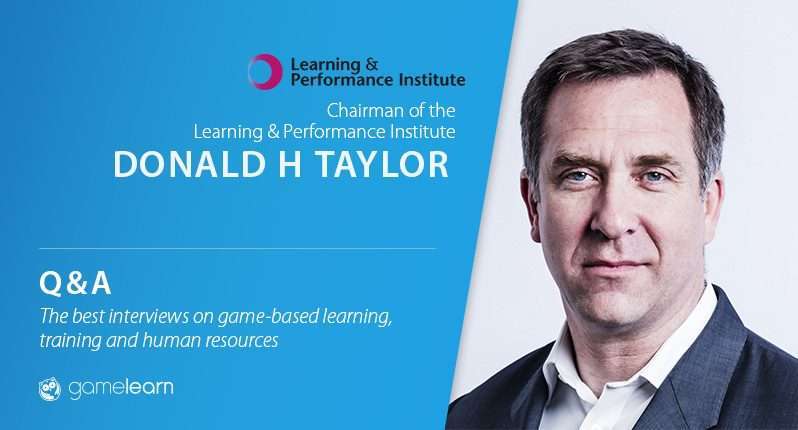Donald H Taylor is one of the most respected and experienced figures in the world of training and development. With more than 25 years of experience, he has devoted his career to helping employees acquire the skills they need, especially with the effective use of technology. Since 2010 he is also the director of the Learning & Performance Institute, one of the most recognized worldwide institutions in the sector.
In this interview, Donald H Taylor explains his vision about the future of training and development, the skills needed by L&D professionals, big data, artificial intelligence or LMS´s.
– You work with many L&D professionals from all kind of organizations all around the world. What is the most common advice you give to them? What general idea do you think is important L&D professionals should understand in order to make their training programs successful?
The single most important thing is to be learning and development professionals. What do professionals do? They know the basics of their profession; they know how to differentiate between what a person wants and what they need. And they know how to put their point across.
A doctor provides help based on her or his expert understanding of your symptoms. Similarly, we need to act professionally by working closely with the business, asking the right questions, and finding the right solutions for short-term performance and long-term capability needs.
Very often these will not be the answers the business asked for, but they will be right for the business, and we need both to persuade the business to come on board with the idea, and then to make it work.
– Modern technologies, including robotization, machine learning and AI, are changing the economy and companies all over the world. What role should training and development professionals play in this? How can they help organizations keep up with these drastic changes?
Many people in L&D see these trends as a threat, and they are – to the traditional training and development approach of creating and distributing learning content.
However, they are also invaluable aids to L&D professionals who really want to help the business. They will enable us to act strategically in the best interest of both individuals and organizations. But to do that, we have to be familiar with them, unafraid of them, and ready to put them to use. Most L&D professionals are nowhere near this.
My tip: get familiar with Ai now, and make it your servant. Otherwise you may well find it your master.
– Looking at this general transformation, many people even talk about the death of the LMS. What is your take on this? Is the LMS dead?
The LMS is nowhere near dead. CAGR growth in the LMS market to 2020 is predicted to be about 22% and 90% of LMS users (according to Fosway) say they will use their LMS the same or more this year.
Until people stop listening to rhetoric and start engaging with reality, we’ll keep wasting a lot of time on this question. Organizations are buying and using LMSs. It’s up to us to make sure this is done well.
– Big data is also bringing change to companies in many areas. In human resources, there is more and more talk about “people analytics”. Do you think big data can also be helpful for training and development? Could it help improve the learning strategies of professionals and companies?
Absolutely. Analytics of all sorts will help people learn and be more productive at work.
My concern – this won’t happen within L&D but in operations, or sales, or wherever the analytics skills reside.
The result: L&D will be left in a backwater, what I call the ‘Training Ghetto’, where L&D is responsible for compliance and onboarding training and nothing more.
My tip: get learning about data and analytics now.
– One challenge that many companies face is how to keep their workforce engaged. This is especially important for training and development professionals, whose programs oftenly fail to motivate and engage their employees. What is the possible solution for this problem?? How can companies and especially L&D departments engage their workers?
Starting with the question of engagement is starting at the wrong end of the problem. It’s like cooking a rich, meaty stew and finding that your dinner guests are all vegetarians and vegans, but still trying to persuade them to eat it.
Begin with the business problem. Always. If you’re providing the answer to a real business need, then you’ll get the managers on board, and with them the employees. Start with a programme that you think people might want, without asking them, and – like your meaty stew – how it is received is down to chance.



Leave a Reply